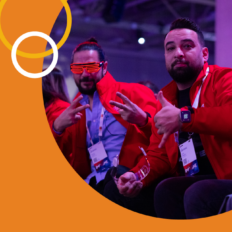As generative AI comes to “life,” in more and more ways, it’s clearly no longer just a buzzword. And it’s transforming—and personalizing—the event experience. From registration, to keynotes, to summary recaps, everyone is trying to figure out the best way to use AI to its potential.
Welcome to the stage, your AI MC!
Could AI host your next event?
One way we’re seeing this added element come to life is through a personal touch. Imagine this: The lights go up. The host walks out on stage and begins a conversation. Almost as if he’s talking to himself. He turns around and his digital twin is on screen behind him, cracking a joke about his outfit and which of the two looks better. The audience breaks out in laughter. You’ve got a comedic opener and have made AI accessible & relatable to the audience.
We’ve tried a similar experience at a client’s flagship event. We created an AI persona that became a key thread throughout the event. After creating the character in our studio, “she” became the event host and interacted with speakers on the mainstage, worked the registration desk as a greeter, and even had a presence on the show floor, helping with wayfinding, or answering hotel and agenda questions. Not only did it help guests, it gave the entire experience more consistency.
With AI, you can generate either the AI version of the host or create a whole new character. Once you create the avatar, it can either be used in a pre-recorded video, or you can train it to be more conversational. But there is risk involved. One drawback of using AI either as a host, or even to help with wayfinding and answering questions, is the lack of control over content. AI is fast and cost effective—quick to create, simple to make day-of changes, and doesn’t come with the risk of a person who could provoke controversy. But you must be thorough in training the algorithms to ensure it doesn’t start sharing content that you don’t want it to share. The more control you want over it, the more of a cost investment it may be.
The AI MC examples span a whole range of capabilities and genres. At Mobile World Congress is Las Vegas, held at the Sphere, humanoid AI robots held conversations with participants and was even able to make facial expression. It’s trained with the same technology as ChatGPT. At the other end of the spectrum, we generated AI images of speakers for one of our client’s events. They popped up on screen when introducing the speakers. While it was simple in a way, the audience couldn’t stop talking about it—It looks just like you, I look so much younger, etc. It was a quick and easy way to implement AI and make the content memorable.
With AI, it’s easier to offer attendees customized agenda recommendations, connect them to expo or sponsorship content directly tied to their interests, and answer specific questions in real-time. From co-hosting an event to answering attendee questions, AI brings together practical tools with fun to surprise and delight your audience. And though it’s a new and different way to engage the audience, it will always need to be complemented by a real human for a truly personal experience.


